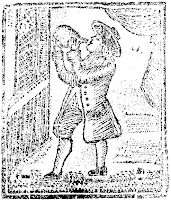By 1782, when Jefferson reworked that manuscript into book form, emancipation advocates like Dr. Benjamin Rush and Voltaire were using Phillis Wheatley’s poetry to argue that people of African descent had shown they were capable enough to deserve freedom.
Jefferson disagreed with that aesthetic judgment about Wheatley’s work, at least in part because he disliked the conclusion it led to. While he continued to aver that slavery was wrong, he used that book to argue that whites were biologically and intellectually superior to blacks. That included literary talent, Jefferson wrote:
Misery is often the parent of the most affecting touches in poetry.—Among the blacks is misery enough, God knows, but no poetry. Love is the peculiar oestrum of the poet. Their love is ardent, but it kindles the senses only, not the imagination.Ignatius Sancho (1729?-1780) was a British man of African ancestry who served in the household of the Duke of Montagu, kept a shop, and published books on music. He supported the Crown during the Revolutionary War. Sancho’s letters were collected and published in London two years after his death—so Jefferson must have pronounced upon them quickly when he “somewhat corrected and enlarged [his Notes] in the winter of 1782.”
Religion indeed has produced a Phyllis Whately; but it could not produce a poet. The compositions published under her name are below the dignity of criticism. The heroes of the Dunciad are to her, as Hercules to the author of that poem.
Ignatius Sancho has approached nearer to merit in composition; yet his letters do more honour to the heart than the head.
Jefferson’s comments betrayed some confusion in his mind as he sought reasons to dismiss the evidence of Wheatley’s talent. On the one hand, he hinted that she didn’t actually write the “compositions published under her name.” On the other, he claimed that their poor quality reflected on her intellect, which meant she had to have written them. Either way, of course, he could derogate her.
Even as Jefferson insisted that blacks’ love “kindles the senses only, not the imagination,” he used the word oestrum, meaning a “period of sexual readiness,” to refer to a poet’s inspiration—a rather sensual image. He praised love poetry but chose Pope’s spiteful satirical Dunciad as his yardstick.
As for Sancho’s letters doing “more honour to the heart than the head,” when Jefferson wrote his dialogue of “my Head & my Heart” in a letter to Maria Cosway as he tried to seduce her in 1786, he ended up favoring his own heart.






